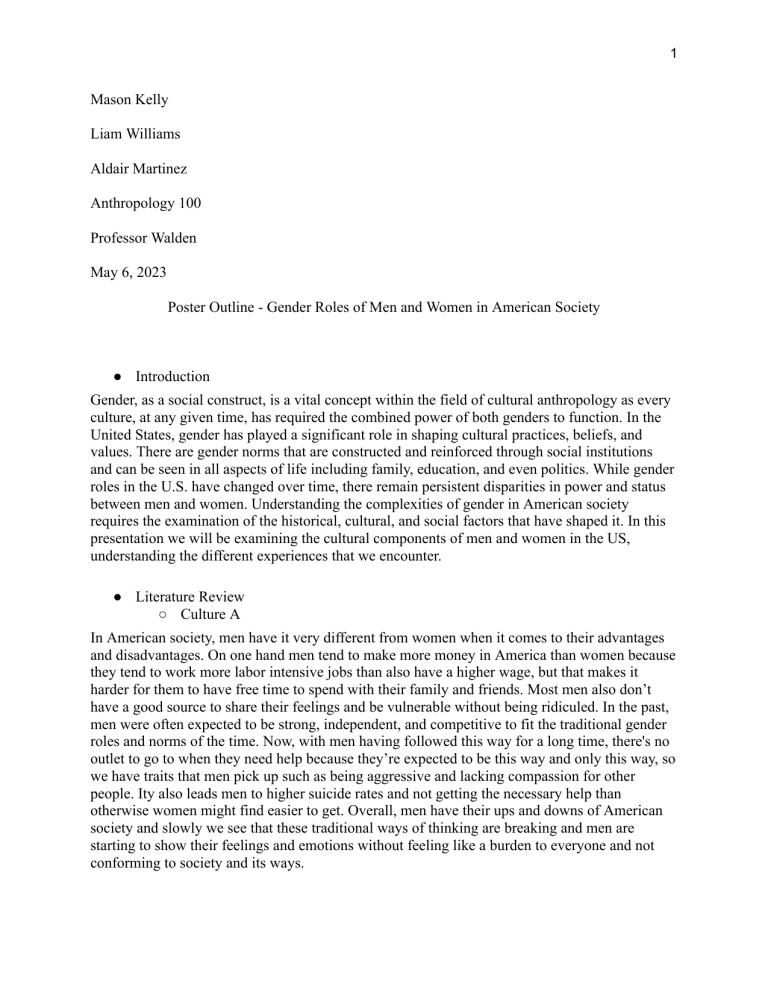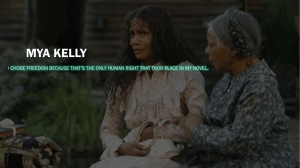
1 Mason Kelly Liam Williams Aldair Martinez Anthropology 100 Professor Walden May 6, 2023 Poster Outline - Gender Roles of Men and Women in American Society ● Introduction Gender, as a social construct, is a vital concept within the field of cultural anthropology as every culture, at any given time, has required the combined power of both genders to function. In the United States, gender has played a significant role in shaping cultural practices, beliefs, and values. There are gender norms that are constructed and reinforced through social institutions and can be seen in all aspects of life including family, education, and even politics. While gender roles in the U.S. have changed over time, there remain persistent disparities in power and status between men and women. Understanding the complexities of gender in American society requires the examination of the historical, cultural, and social factors that have shaped it. In this presentation we will be examining the cultural components of men and women in the US, understanding the different experiences that we encounter. ● Literature Review ○ Culture A In American society, men have it very different from women when it comes to their advantages and disadvantages. On one hand men tend to make more money in America than women because they tend to work more labor intensive jobs than also have a higher wage, but that makes it harder for them to have free time to spend with their family and friends. Most men also don’t have a good source to share their feelings and be vulnerable without being ridiculed. In the past, men were often expected to be strong, independent, and competitive to fit the traditional gender roles and norms of the time. Now, with men having followed this way for a long time, there's no outlet to go to when they need help because they’re expected to be this way and only this way, so we have traits that men pick up such as being aggressive and lacking compassion for other people. Ity also leads men to higher suicide rates and not getting the necessary help than otherwise women might find easier to get. Overall, men have their ups and downs of American society and slowly we see that these traditional ways of thinking are breaking and men are starting to show their feelings and emotions without feeling like a burden to everyone and not conforming to society and its ways. 2 ○ Culture B Women have made significant strides in American society because at one point they didn’t even have a voice, and they couldn’t express their opinions because it was thought that they were rash and too emotional to make important decisions. Even still to this day, women are still fighting the same battle that they have been fighting for decades, their discrimination has been present and known, but no effort has been made. We have seen many times that they face discrimination in the workforce and have to deal with constant sexual harassment from their coworkers. On top of that, they have to deal with unequal pay, and look over the advancement of a job in the workforce. Women were also one of the last people to get voting rights in America and a big one was when women were allowed the choice to get an abortion back in 1973 which was sadly overturned. We are also seeing an increase in women taking leadership roles. Women have also done multiple marches and peaceful protests about the issues they face in society and one of the bigger ones was the MeToo movement were women wanted to bring awareness about assault and sexual harassment that they face not only in the workforce, but just when they go out into public and how that can be dangerous for their own wellbeing and safety. These all have been big strides that women have taken in society and we truly see that they have a voice and it is shouting proudly. ● Discussion Gender has always plagued U.S. society in that there are always arguments for which gender gets better opportunities in society and which gender has faced certain discrimination and who got it more harsher. Also, race has played a huge factor in family life. Black American families have the highest chance at 64% chance of being a single parent family, mostly single motherhood, according to the AECF.org statistics in 2019. So if we also look at races amongst genders, we can also see discrepancies where there can be a gray area in which some women will have favorability while the other doesn’t in American society. We also see in other societies the common trope that the man has to provide for the family while the women should look after the kids, but as of late and especially in the United States, we see a shift moving away from this idea and more to women and men both being able to work and take care of the kids. We no longer see this average American family with a white picket fence dream that we would see in the 1950’s 1960’s. Women don’t want kids anymore and men don’t want to get married because if divorce happens they lose more than the wife. Throughout time, gender roles change and become further flexible as we begin to see the divide between genders crumble. It is no longer about the powerful masculine man and the feminine obedient women. A person can be whoever they want to be, disregarding these aged preset roles. ● Conclusion There have been and will be challenges and progress that have been and will be made by different genders in American society. While men have faced difficulties in expressing their emotions and being vulnerable due to societal expectations, women have fought for their voices to be heard and for equal treatment in the workforce and in society as a whole. It is important to recognize the paramount progress that has been made throughout several decades but also acknowledge that there is still work to be done in achieving true equality and dismantling gender 3 stereotypes and biases. By continuing to challenge these societal norms and advocating for fundamental change, we can create a more inclusive and just society for all genders. ● 5-8 credible References in APA format, one of which should be the course textbook Cheung, E., & Mui, A. C. (2023, March). Gender Variation and Late-life Depression: Findings from a National Survey in the USA. Ageing International., 48(1), 263-280. https://doi.org/10.1007/s12126-021-09471-5 Edelmann, A., & Vaisey, S. (2023, January 18). Gender differential effect of college on political orientation over the last 40 years in the U.S.—A propensity score weighting approach. PLoS ONE., 17(1), 1-13. https://doi.org/10.1371/journal.pone.0279273 Munsch, C. L., & Davis, S. M. (2021). Marital Status, Gender, and Race in The U.S.: Perceptions of Middle-Aged Men and Women1. Journal of Comparative Family Studies., 52(4), 596-622. https://doi.org/10.3138/jcfs.52.4.04 Setzler, M., & Yanus, A. B. (2021). Gender and Support for Democracy in the United States and Canada. Political Science Quarterly (Wiley-Blackwell)., 136(3), 521-546. https://doi.org/10.1002/polq.13236 Welsch, R. L., & Vivanco, L. A. (2021). Cultural Anthropology: Asking Questions About Humanity (3rd ed., pp. 277-303). : Oxford University Press.




